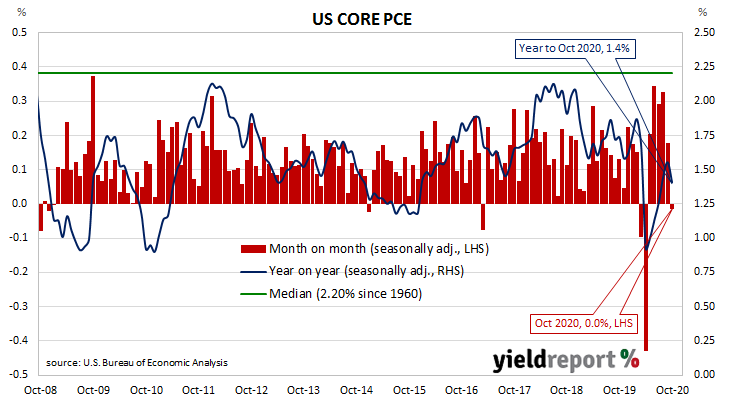Summary: US Fed’s favoured inflation measure flat in October; in line with market expectations; annual rate falls after rising for five months; “inflation moderating steadily since June; little movement from Treasury bond yields.
One of the US Fed’s favoured measures of inflation is the change in the core personal consumption expenditures (PCE) price index. After hitting the Fed’s target at the time of 2.0% in mid-2018, the annual rate then hovered in a range between 1.8% and 2.0% before it eased back to a range between 1.5% and 1.8% through 2019. It then plummeted below 1.0% in April 2020 before rising in the June and September quarters.
The latest figures have now been published by the Bureau of Economic Analysis as part of the October personal income and expenditures report. Core PCE prices remained unchanged after rounding over the month, in line with expectations but lower than September’s 0.2% increase. On a 12-month basis, the core PCE inflation rate slowed from September’s revised rate of 1.6% to 1.4%.
“Monthly inflation has been moderating steadily since June and the annual measure has been below the Fed’s 2.0% target since average inflation targeting was announced in August. Undoubtedly the Fed will be hoping for additional fiscal stimulus to help meet its objectives,” said ANZ economist Daniel Been.

US Treasury bond yields did not move much on the day. By the close of business, the 2-year Treasury bond yield remained unchanged at 0.16%, the 10-year yield had slipped 1bp to 0.88% while the 30-year yield finished 1bp higher at 1.62%.
The core version of PCE strips out energy and food components, which are volatile from month to month, in an attempt to identify the prevailing trend. It’s not the only measure of inflation used by the Fed; it also tracks the Consumer Price Index (CPI) and the Producer Price Index (PPI) from the Department of Labor. However, it is the one measure which is most often referred to in FOMC minutes.

